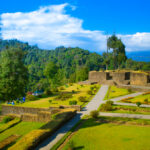Now Reading: Top 12 Places to Visit in Ajmer for Spirituality, Heritage & Scenic Beauty
-
01
Top 12 Places to Visit in Ajmer for Spirituality, Heritage & Scenic Beauty

Top 12 Places to Visit in Ajmer for Spirituality, Heritage & Scenic Beauty
1. Khwaja Gharib Nawaz Dargah Sharif

The design of Ajmer-e-Sharif Dargah shows the combination of Mughal and Rajput architectural elements in a striking manner. The building displays regal domes along with elegant marble artwork along with enormous gates and grand arches. Inside the dargah grounds visitors can view a set of features that include Buland Darwaza as well as Jannati Darwaza, Jhalra, Tank Victoria and a large cauldron and tomb of Nizam Sikka. When you visit the dargah you can perform prayers while local musicians present spiritual qawwali performances.
A lively market stands right outside Ajmer-e-Sharif Dargah where visitors can purchase mementos before ending their day.
You should visit Ajmer-e-Sharif Dargah for prayers and blessings which draws numerous visitors to this religious point in India.
- Admire stunning white marble carvings on the tomb of Moinuddin Chisti, a pious saint.
At Mehfil Khana you can listen to the moving qawwali performances which provide peaceful and spiritual entertainment.
The Dargah market offers an excellent opportunity to buy holy books and tasbih along with handwoven fabrics, jewellery and attar and traditional prayer beads.
The most favorable time to visit is during either the Urs festival of Ramadan or Eid since they create sacred moments for visitors.
The dargah is most serene and easily explored on weekdays because weekend crowds are minimal at this time.
The most suitable times to explore the dargah are the early mornings and late afternoons because they offer peaceful conditions with lower crowds.
2. ADHAI DIN KA JHONPRA

Among all the attractions in Ajmer stands out the marvelous Adhai-din-ka-Jhonpra mosque at the town border which ranks as one of the must-see sites in Ajmer.
The legend states that builders finished the structure within two-and-a-half days in 1153. The site gained its name during the celebration of a two-and-a-half day festival according to a different account. A Sanskrit college initially stood where Muslim ruler Mohammed of Ghori established his mosque through construction of a seven-arched entry that displayed Islamic writing facing the pillared hall.
Despite needing renovation the structure remains magnificent through its domes and arched screen and pillars constructed primarily from temple ruins of Jain and Hindu faith.
The site stands in Andere Kota road where it offers simple access to visitors.
The mosque remains accessible from 4:30 AM up to 8:30 PM each day.
3. Nasiyan Jain Temple

The religious landmark Nasiyan Temple exists as Lal Mandir (Red Temple) on Prithvi Raj Marg in Ajmer. Since its construction in 1865 Nasiyan Temple has become a distinguished tourist site in Ajmer that worships Lord Adinath the first Jain Tirthankara.
The religious part and museum space make up the double section of this temple complex. Visit this prayer area to see the Lord Adinath idol which peacefully acts as a focus for devotion. The museum section decorated in gold displays a wonderful gallery that portrays Lord Adinath’s life phases and captures the attention of all visitors.
The temple features a large space of 3,200 sq. ft consisting of a hall exhibiting remarkable workmanship. The Temple decorations include Belgium stained glass, detailed glasswork along with luxurious silver and gold details which led people to call it the ‘Golden Temple of Ajmer’. The temple seeks visitors’ admiration through wooden gold representations along with mesmerizing glass illustrations and intricate paintings that increase its grandeur.
Location
People visiting Ajmer should ensure Nasiyan Temple stands at Prithvi Raj Marg because visitors access it through taxis while exploring the city.
Timings
A visit here is possible from morning to evening since this holy place opens its doors at 7 AM and stays open until 7 PM each day.
4. GATEWAYS OF TARAGARH FORT

Taragarh Fort ranks among Ajmer’s most historic and magnificent landmarks. During the 12th-century AD when the Chauhan Empire ruled this hilltop fortress displayed both architectural achievements of Rajasthan and military importance.
The three monumental entrances of Taragarh Fort retain historical and architectural value which makes them stand out as principal characteristics of this site.
- Lakshmi Pol
- Phuta Darwaza
- Gagudi ki Phatak
In their ruined state these gateways demonstrate exceptional Mughal architectural elements through their carved details and inscriptions as well as their historic locking mechanisms which attract present day viewers.
History
The military outpost of Taragarh Fort acted as a vital defense station due to its control of trade paths while cultivating influential observation of the nearby territory. During sieges the fort used its massive reservoirs as an engineering achievement that enabled water storage.
Location
- Location: Nahar ka Chauhatta, Bundi, Rajasthan 323001
- The site remains accessible during daily hours between 8:00 AM to 7:00 PM.
5. NARELI JAIN TEMPLE

The Nareli Jain Temple stands in the corner of Ajmer at a seven-kilometer distance from its central area as a contemporary Jain temple that mixes traditional elements with modern architectural aesthetics.
Having 24 additional miniature temples erected on the hill functions as symbolic representations of Jain’s Thirthankar’s who are known as 24 Jainalay.
The temple received significant importance from Digambara Jains while drawing visitors because of its elaborate artwork and sculptures.
The sightseeing experience at Jain Temple Nareli pairs well with various spots scattered throughout the city.
The place can be found on the main national highway no. 8 where it serves as a six-lane expressway which connects with Jaipur. Both autos and taxi transportation services are accessible from Ajmer and from surrounding towns.
Timings: Opened daily from 7 AM to 7 PM.
6. ANA SAGAR LAKE

The historical and beauitful artificial Ana Sagar Lake exists in Ajmer, Rajasthan, India. King Anaji Chauhan built the 12th century water reservoir which encompasses 13 kilometers of water surface while Daulat Bagh and other gardens maintain their growth around it. Lovers of both tourists and locals visit the peaceful lake to enjoy its beautiful views. Many visitors enjoy cruising on the peaceful lake waters because boating has become a traditional activity at this site. Ana Sagar Lake maintains vital historical value that distinguishes it as the most important monument in Ajmer while offering its visitors recreational pleasure.
Experience the magnificent Ana Sagar Lake by understanding its historical and cultural story.
A boat tour through the lake will bring you to its central island where you can create enduring memories during this relaxing boat journey.
The sights of Ajmer Sharif Dargah and Daulat Bagh Garden and Taragarh Fort along with Baradari Pavilion await visitors in the near vicinity of Ana Sagar Lake.
The local street offerings include pav bhaji as well as aloo sabji with puri and gol gappe and bhel puri and cotton candy.
The nearby markets offer Rajasthani handicrafts and textiles which make perfect items to purchase as souvenirs.
Read More
The pathway to visit Ana Sagar Lake in Ajmer starts from two main entrance points.
The lakesite exists 5 km from the Ajmer city center. Tourists need approximately 13 minutes to reach the lake by traveling on the Pushkar road. The lake becomes accessible through taxis operating from every location in the city. Ana Sagar Lake visitors have the choice of utilizing auto rickshaws as a reasonably priced method of transport that can be found throughout the city.
The most suitable season to explore Ana Sagar Lake in Ajmer occurs between November and February during the winter period. During the winter season the climate at the lake remains comfortable so visitors can fully enjoy both the fantastic views of the lake region. You can take advantage of the pleasant weather to explore the area by boat rides and relax in the serene atmosphere during this season since it remains free from summer heat and monsoon rains.
7. Foy Sagar Lake

This artificial lake near Ajmer city operated during the famine times serves the purpose for which it was constructed. Foy Sagar Lake from the 19th century receives its name from Mr. Foy who designed and built the man-made water reservoir as an Englishman. Visitors from all over Ajmer adore Foy Sagar as one of the most beautiful landmarks because it provides spectacular views of the surrounding Aravalli peaks.
During winter visitors can have the perfect experience at this Lake for picnics. Foy Sagar ranks as a top pick among Ajmer tourists who spend one day in the city because of its famous sunset viewing spots which draw romantic couples. Throughout every season birds occupy the lake which draws birdwatchers and photographers to this site.
Foy Sagar Garden Road in Ajmer identifies as the place where this attraction resides.
Timings: Open 24 hours.
8. AKBARS PALACE MUSEUM

Archaeological Museum was established in 1949. This museum divides its exhibits into three sections within the Dil-e-Aaram Gardens of Ajmer which ranks among the best attractions for visitors to the city.
The museum contains sculptures alongside earlier civilizations excavation material that includes two Yupa Pillars used for sacred ceremonies. The establishment showcases Prathihara sculptures from the 8th century together with early historical terracotta artifacts and Barnala and Prathihara inscriptions in its collection.
The museum maintains its position in the former royal center of Jaipur where it displays artifacts uncovered at Rairh, Bairat, Sambhar, Nagar, along with other retrieved objects.
The museum displays sculptures and inscriptions that originated from different locations within the previous Jaipur State realm which were originally kept at Vidyadhar Gardens.
The venue of the museum exists in Akbar fort making it accessible through any form of local transport.
Timings: Opened daily from 10 AM to 4:45 PM.
The entry fees start at 25 INR.
9. Daulat Bagh

Daulat Bagh rests tranquilly along the waterfront of Ana Sagar Lake to become a premier historical garden in Ajmer. The lush gardens at Daulat Bagh were established in 1868 by Emperor Shiv Dan.
History
Guests visit Daulat Bagh because of its vast green terrains which include naturally occurring trees that provide soothing calming effects. The Baradari marble pavilions stand as a graceful addition to the garden because Emperor Shah Jahan built them. The regal structures establish Mughal grandeur among the beautiful natural scenery.
Daulat Bagh presents visitors with an excellent environment for peaceful walks between its wide-open areas which host excellent lawns and permits both relaxation by meditation and photo opportunities and food-based recreation. Visitors can find this location among the top relaxation spots in Ajmer because it offers breathtaking lake views toward Ana Sagar Lake.
- Location: Near Ana Sagar Lake, Ajmer, Rajasthan 305001
- Visitors can explore Daulat Bagh between 9:00 AM until 6:00 PM every day.
Daulat Bagh
- Scenic Beauty: Stunning lakeside views and lush greenery.
- Historical Significance: Built during the Mughal era, with pavilions by Shah Jahan.
- Peaceful Retreat: A perfect spot for relaxation and photography.
- Cultural Experience: A blend of nature, history, and Mughal architecture.
10. VICTORIA JUBILEE CLOCK TOWER

Along the shore of Ana Sagar Lake sits Daulat Bagh which stands as one of the historical and picturesque spots in Ajmer. This lush green recreational site emerged during 1868 under the construction of Emperor Shiv Dan.
History
Daulat Bagh receives fame for its wide green areas which feature spontaneous tree growth that attracts restful experiences for all visitors. The garden reveals a serene atmosphere through Baradari marble pavilions that Emperor Shah Jahan had built. The Mughal elements in these buildings bring regal sophistication to the delightful environment.
Visitors can appreciate Daulat Bagh through various activities such as walking, enjoying picnics, taking photos and following meditative practices because it features expansive meadows alongside excellent lawn maintenance. The scenic vista across Ana Sagar Lake together with leisure opportunities makes it rank among Ajmer’s finest sites to rest and explore natural vistas.
The Victoria Jubilee Clock Tower stands as a distinguished landmark in Ajmer because it was built during the Golden Jubilee of Queen Victoria in the nineteenth century. At present the structure operates as a key monument representing Ajmer’s historical significance.
The Clock Tower showcases an exquisite blend of Indo-Islamic architectural styles. Strategic balconies with individual Islamic dome crowns provide visitors with an amazing panoramic outlook across the nearby urban panorama. The symbolic Clock Tower distinguishes itself as a prominent monument throughout the city of Ajmer.
Location and Accessibility
- Daulat Bagh Location: Near Ana Sagar Lake, Ajmer, Rajasthan 305001
- Clock Tower Location: Victoria Jubilee Clock Tower, Hathi Bhata, Parao, Ajmer, Rajasthan 305001
- The sites maintain daily business hours between 9:00 AM until 6:00 PM.
Visit Daulat Bagh & the Clock Tower
Scenic Beauty: Stunning lakeside views and lush greenery at Daulat Bagh.
The site comprises a notable Mughal garden from the past in addition to a British-made monument that dates from the nineteenth century.
Architectural Grandeur: Shah Jahan’s marble pavilions and Indo-Islamic designs of the Clock Tower.
Cultural Experience: A blend of nature, history, and architectural excellence.
11. PRITHVIRAJ SMARAK AJMER

A monument named Prithviraj Smarak serves to honor Prithviraj Chauhan who stood as the exceptional hero of Rajput Chauhan dynasty. The memorial positioned on the Taragarh Road in Ajmer displays a black stone statue of the king riding a horse.
The depiction of Prithviraj Chauhan shows him carrying a bow and arrow in his possession. The last member in the succession line of Chauhans was initially recorded as Prithvi Raj III who used the name Prithvi Raj Chauhan. During the twelfth century the ruler received his throne to govern both Delhi and Ajmer as separate capitals. Society honored him as the highest definition of bravery and loyalty towards his country.
You can reach this location on Taragarh Road inside Ajmer by using any of the available local transportation systems.
Timing: Opened daily from 7 AM to 9 PM.
12. MAHARANA PRATAP SMARAK

The historical monument receives its popular name as the King of the Hill because it honors Maharana Pratap who was the last king of Rajasthan. A hill-top memorial shows the King mounted on his steed as he progresses to fight against enemy warriors. The surrounding town beauty becomes visible from the monument while also serving as a major Ajmer viewpoint so it stands as a top Ajmer attraction that can be visited in one day.
The adjacent selfie point offers visitors the perfect opportunity to take memorable pictures of their Ajmer memories. Every day the monument conducts an evening light and sound presentation about Ajmer’s historical development under Maharana Pratap’s governance.
Location: 301, Pushkar Rd, near Haribhau Upadhyay Nagar Extension, Nosar Ghati, Rajasthan 305001.
Timings: Open 24 hours.
Related articles : Top 15 Places to Visit in Thane for Nature, Heritage & Family Fun
Stay Informed With the Latest & Most Important News
Previous Post
Next Post
-
 01Top 5 Best Places Visiting in Gyalshing – Monasteries, Lakes & Scenic Escapes
01Top 5 Best Places Visiting in Gyalshing – Monasteries, Lakes & Scenic Escapes -
 02Top 5 Best Places Visiting in Panna – Temples, Waterfalls & Wildlife Escapes
02Top 5 Best Places Visiting in Panna – Temples, Waterfalls & Wildlife Escapes -
 03Top 5 Best Places to Visit in Malerkotla – Malerkotla Fort, Sheesh Mahal & More
03Top 5 Best Places to Visit in Malerkotla – Malerkotla Fort, Sheesh Mahal & More -
 04Top 10 Best Places Visiting in Dakshina Kannad for Culture, Nature & Coastal Charm
04Top 10 Best Places Visiting in Dakshina Kannad for Culture, Nature & Coastal Charm -
 05Top 2 Best Places Visiting in Chitradurga for History, Nature & Adventure
05Top 2 Best Places Visiting in Chitradurga for History, Nature & Adventure -
 06Best Places Visiting in Shopian – Explore Top Attractions & Hidden Gems
06Best Places Visiting in Shopian – Explore Top Attractions & Hidden Gems -
 07Best Places Visiting in Narmadapuram – Temples, Waterfalls & Wildlife Escapes
07Best Places Visiting in Narmadapuram – Temples, Waterfalls & Wildlife Escapes














Pingback: Top 10 Places to Visit in Alwar – Complete Travel Guide